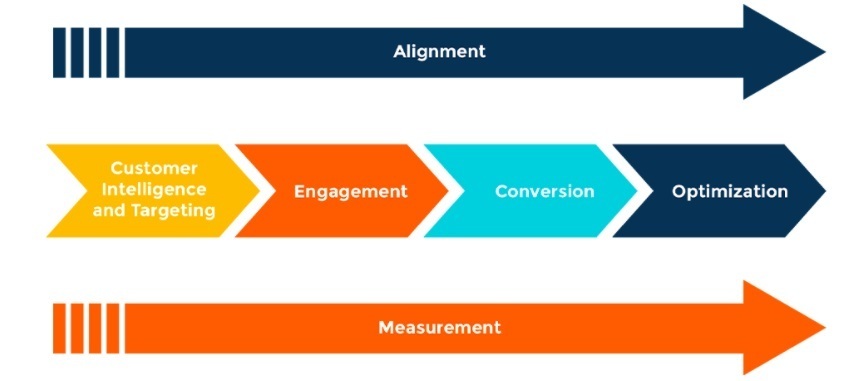Account-based marketing (ABM) is hard! It is a new way of marketing for many and those who have adopted ABM struggle for the first year or so. In this post, we provide an overview of the ABM process.
Having a clear playbook helps. At healthlaunchpad, we have developed an ABM process, a methodology anyone can use to get your ABM program moving.
It’s a process that you can implement in 90-days and can scale with you.
An Overview of the ABM Process
The diagram above outlines the steps. In short, the healthlaunchpad ABM process has four key steps, from target development through optimization.
These are underpinned by two critical foundations: Alignment and Measurement.
In developing this ABM process, we have borrowed from masters of ABM like Terminus, 6sense, and Demandbase. And it is also based on three decades of developing marketing strategies across many industries.
We have also brought in some new ideas from our work with health tech marketers and learning what works and doesn’t.
It’s something new, something old, something borrowed.
Targeting and Customer Insight – The Critical First Step in the ABM Process
Everything starts with developing a Target Account List (TAL) of Best Fit Accounts.
This is critically important. One of the key things that is different about ABM is that you are making decisions about who you will NOT target just as much as you are deciding who you WILL target.
You will then focus your resources on that TAL.
If you get your TAL wrong, you will be expending effort, resources, and money trying to win unwinnable or the wrong accounts.
In this supplementary post, we review the ABM process in more detail with respect to your Target Account List. It will also lead to other resources on how to determine Best Fit Accounts, create an Ideal Customer Profile (ICP), and more.
The second key difference between targeting in ABM is the greater emphasis on customer insight.
You need to gather as much insight about your prospects as you can. This includes smart analysis of any data you have about customers, your website analytics, and data from your CRM.
Bolster this with qualitative insights from customer interviews and what your salespeople report from direct interactions. Collectively this is known as first-party data.
Intent Data – The Magic That Gives ABM its Superpowers
Intent Data is third-party behavioral data that gives you signals about who may be “in-market” for your services and solutions.
The data collected about web users’ observed behavior – specifically web content consumption – provides insights into their interests. This insight often indicates potential intent to take a specific action.
For businesses, that means understanding who might be inching closer to a buying decision or the nuances of the most common path towards a sale or conversion. Its application is discussed more under engagement.
We recommend watching this webinar for a detailed overview of developing your Best Fit Target Account List. This is one of the 6-part series we created with HIMSS.
Engagement – How You Will Move Prospects from Distant Strangers to Loyal Customers
The ABM Process is about creating ways to engage buyers earlier in the journey.
As we discussed in this post, traditional B2B marketing is no longer working because it depends on interruption and getting prospects to give up their contact information when they are not ready to do that.
When you adopt ABM, you are trying to solve the eternal challenge of reaching the right customers early in their purchase process, as depicted here.

Everything starts with insights about the buyer. Like many organizations, we use personas to capture insights about the individuals at the target accounts we are trying to reach.
In developing your personas, focus on coming up with the questions they ask as they go through the process.
These buyer questions are the foundation of your engagement strategy. You will use these to decide:
- Content strategy
- Your messaging strategy
- How you will engage the buyer at each step in the journey
- SEO strategy
- Email and nurture game plan
- Your outbound approach
- And more
For the definitive guide on how to do this, read They Ask You Answer by the awesome Marcus Sheridan.
Creating a brilliant ABM engagement model is part Art and part Science
The Art is the quality of the content you create.
The science is using behavioral insights to reach your buyer at the right time with the right message. This is where intent data is so valuable.
For example, if your intent data is signaling that 50 of your top 200 accounts appear to be actively in-market and seem predominantly interested in the topic of integration with Epic. How do you respond?
You might start by writing a great 700-word blog post on this topic.
Then reach out to prospects with that blog post. Your sales development reps (SDRs) may email it to known contacts at these 50 accounts.
You can also run an intent-based ad campaign by connecting your intent data to LinkedIn ads or a demand-side network.
This enables you to target ads about the given topic, in this case, integration with Epic, to just people at the 50 in-market accounts.
I recommend you watch two of the webinars we conducted with HIMSS that go into engagement in greater detail:
- “Implementing and Optimizing ABM Campaigns” – This goes into the process in detail, especially how to leverage intent data. It also includes an in-depth review of how a health tech company, Nuvolo, utilizes ABM.
- “What’s Next in ABM?” – This provides a perspective on where ABM is going, including an in-depth look at Account-based Experiences (ABX).
Conversion – How the ABM Process Changes the Way Sales and Marketing Operate
ABM’s biggest effect on your sales and marketing is the process between the two departments.
In a typical B2B marketing scenario, there is a hand-off of Marketing Qualified Leads (MQLs) to the SDRs to qualify these and then hand them off as Sales Qualified Leads (SQLs) to sales execs to close.
What changes when you embrace ABM is that sales and marketing work much more closely together. It starts to look like this:

The model shifts from sequential hand-offs to a real-time collaboration model
If you are lucky enough to have an ABM platform like Terminus, 6sense, or Demandbase, your SDRs will not only see what new leads have come in from accounts, but they will see what prospects at those accounts are doing on your website, what else they are interested and how actively engaged they are in the process.
In the words of the manager who runs the ABM programs at ABM, the SDRs shift from “being proactive to being reactive.”
Prospecting becomes easier because the SDRs focus on fewer, more engaged prospects, reacting to what is known about them at that moment.
In the webinar, “Implementing and Optimizing ABM Campaigns,” we discuss this in detail.
For this to work, sales and marketing need to be in lockstep. It means changing up the process and routines for sales and marketing.
It also can lead to changing responsibilities across your marketing and sales teams, even adding new roles.
Optimization – Real-time and Continuous
As in any marketing program, you need to optimize all the time.
Because ABM is so new, it can take several years to perfect. You can shorten the time to ABM competence by developing a disciplined continuous improvement model.
This starts with an ABM Roadmap. Typically, we recommend that you create a 12-18-month roadmap and break this up into a series of 90 or 120-day sprints.
In each sprint, you will run an experiment designed to improve on where you currently stand in your ABM journey.
Here is an example of what this might look like.

We run workshops on this. This includes designing your first experiment.
You can download the framework for this here. If you are interested, you can schedule a call with us to discuss this in more detail.
Real-time Optimization
The most important difference in how you optimize in ABM is the ability to optimize in real-time.
As your sales and marketing team gets more experienced in understanding the different data and signals that an ABM platform provides, they will be able to react in real-time.
For example, in this screenshot from Terminus, the team will understand immediately that “Asset Management” is the top topic being researched by their TAL.

They can then adapt in real-time to target Asset Management content and messaging to the TAL.
As you become more confident in reacting to this data, you can automate this with nurture workflows and intent-based ad campaigns.
This is a real-time optimization.
In terms of your ABM Process, you will need to develop routines for sales and marketing to learn, adapt and develop a systematic way to respond to changes in the behavior of targets.
Measurement: ABM=Always Be Measuring
Measurement is even more important in ABM than in traditional B2B marketing.
The most important issue to consider is what you measure in ABM. With ABM, you can track so much information that it can become overwhelming in a hurry. The critical thing is to have a clear strategy for what you are ultimately trying to measure.
ABM enables you to measure strategically more important KPIs such as the velocity of your funnel, average deal size, close rates. These Revenue Performance KPIs give you a much better predictor of future success.
You Can’t Get There Overnight.
Measuring ROI is the #1 challenge reported by experienced ABM practitioners. It can take several years to perfect.
A key part of your ABM process will be to develop a game plan for how you will get to these higher-order KPIs that both prove its ROI and provide the company’s management with reliable forecasting data.

This diagram shows that the Revenue Performance measures are built on a foundation of Marketing Performance measures that come from your website and other campaign data.
Here are examples of these measures:
Revenue Performance
- Close rates
- Deal size
- Funnel velocity
Marketing Performance
- TAL engagement
- TAL penetration
- Cost per opportunity
Campaign and Web
- Web site visits
- Downloads
- Time on site
- Email open rates
As you design your ABM process, consider carefully how you will evolve your measurement process. In the short term, pick a few new ABM measures, such as your Target Account List (TAL) engagement. Over time, add more sophisticated measures such as pipeline % accounted for by the TAL and progress towards higher-order measures such as TAL close rate and TAL deal size.
Alignment – The Weakest Link in the ABM Process
ABM is a team sport.
Or said, another way, ABM does not work unless sales and marketing are aligned. Research shows that alignment is the single biggest reason why ABM programs fail. When ABM works, sales and marketing are both more productive, working relationships are better, sales feel that marketing is making more of a contribution, and marketing feels that they are making a more measurable impact on revenue.
ABM is complex and requires many people to work in concert. The problem is that change sucks! No one wants to do something different even if what they are currently doing is not working well. Building alignment is a gradual process. Start small and grow as you get positive results.
The key is to have a deliberate approach to building alignment in your ABM process. When you start, you may want to design a limited experiment pairing a marketing manager with one or two SDRs. As you get results, you may want to include the sales executives responsible for a market segment and develop a segment-specific ABM experiment with them.
Eventually, everybody will want to be part of this.
As you grow the alignment, changing processes and behaviors will be easier.
Getting Started with your ABM Process
I hope that the information above is helpful. We know how challenging this is, and we can help.


